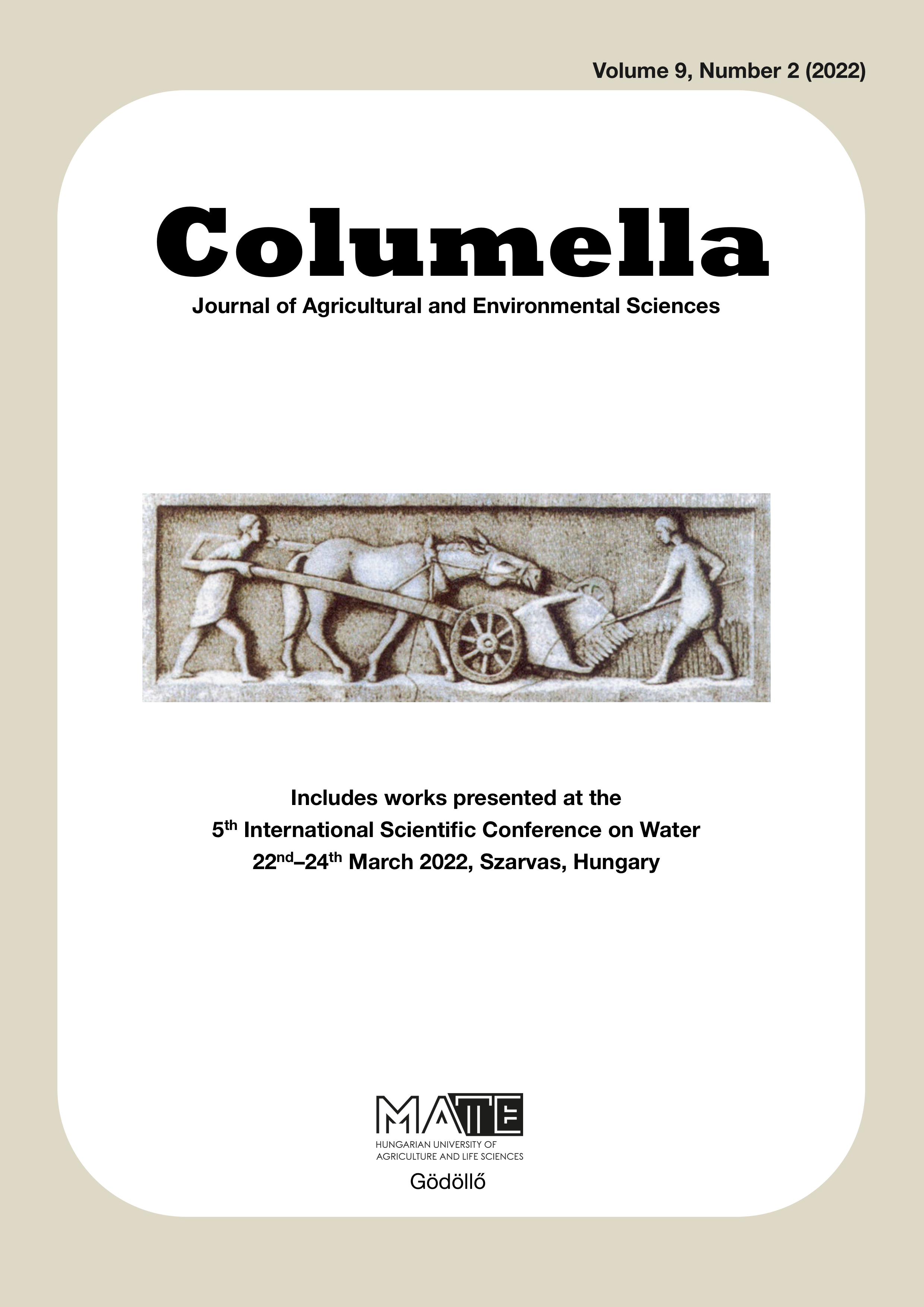Effect of cereal-legume intercrops on the soil enzymatic activity
DOI:
https://doi.org/10.18380/SZIE.COLUM.2022.9.2.123Keywords:
soil enzyme activity, cereal-pea intercrops, plant associations, winter peaAbstract
Sowing and harvesting cereals with legumes is an old crop production practice. The main goal of cultivation is to make the best use of the area and to increase the quality and yield of the crops. The intercropping of cereals and legumes can stimulate the biological activity of the soil, thus increasing the recycling of soil organic matter. Competition between two or more plants has a positive effect on the nitrogen fixation of legumes. In organic form the soil enzyme activity increasing is more effective which is provided by the winter pea (Pisum sativum L.) in this crop production system. We set up our experiment at the experimental sites of the Hungarian University of Agriculture and Life Sciences, Plant Production and Agrotechnical Research Station, Szeged-Öthalom and Fülöpszállás in 2020/2021. The experiments were performed on 10 m2 plots, in four replicates, with four cereals and one winter pea species, in different phenological phases. We were used fluorescein diacetate to determine the total microbial activity of the soil. As the phenophases progress, the enzymatic activity of the soil decreases, and activity is affected by soil type. The soil enzyme activity was lower on meadow chernozem soil and higher on calcareous meadow soil. Cereal-legume intercrop systems are better able to adapt to drought. The values are higher in cereal-legume intercropping system than in cereals sowed alone. Based on our results, it can be concluded that the enzymatic activity of the soil can be increased by using soil inoculation with bacteria and mycorrhiza fungi preparations.
References
Adam, G., & Duncan, H. (2001). Development of a sensitive and rapid method for the measurement of total microbial activity using fluorescein diacetate (FDA) in a range of soils. Soil Biology and Biochemistry 33(7), 943-951. doi: https://doi.org/10.1016/S0038-0717(00)00244-3
Antal, J. (2005). Növénytermesztéstan 2. Budapest: Mezőgazda Kiadó.
Bandick, A. K., & Dick, R. P. (1999). Field management effects on soil enzyme activities. Soil Biology and Biochemistry 31(11), 1471-1479. doi: https://doi.org/10.1016/S0038-0717(99)00051-6
Baulcombe, D., Crute, I., Davies, B., Dunwell, J., Gale, M., Jones, J., . . . Toulmin, C. (2009). Reaping the benefits: science and the sustainable intensification of global agriculture. London, United Kingdom: The Royal Society.
Birkás, M., Jolánkai, M., Kisić, I., & Stipešević, B. (2008). Soil tillage needs a radical change for sustainability. Agriculturae Conspectus Scientificus 73(3), 131-136.
Biró, B., Domonkos, M., & Kiss, E. (2012). Catabolic FDA microbial activity as site- dependent monitoring tool in soils of an industrial town. International Review of Applied Sciences and Engineering 3(1), 41-46. doi: https://doi.org/10.1556/irase.3.2012.1.5
Bocz, E. (1996). Szántóföldi növénytermesztés. Budapest: Mezőgazda Kiadó.
Cai, H., You, M., & Lin, C. (2010). Effects of intercropping systems on community composi- tion and diversity of predatory arthropods in vegetable fields. Acta Ecologica Sinica 30(4), 190-195. doi: https://doi.org/10.1016/j.chnaes.2010.06.001
Dahmardeh, M., Ghanbari, A., Syasar, B., & Ramroudi, M. (2009). Effect of Intercropping Maize (Zea mays L.) With Cow Pea (Vigna unguiculata L.) on Green Forage Yield and Quality Evaluation. Asian Journal of Plant Sciences 8(3), 235-239. doi: https://doi.org/10.3923/ajps.2009.235.239
Dick, R., Rasmussen, P., & Kerle, E. (1988). Influence of long-term residue management on soil enzyme activities in relation to soil chemical properties of a wheat-fallow system. Biology and Fertility of Soils 6(2), 159-164. doi: https://doi.org/10.1007/bf00257667
Füleky, G. (1999). Tápanyag-gazdálkodás. Budapest: Mezőgazda Kiadó.
Hardarson, G., & Atkins, C. (2003). Optimising biological N2 fixation by legumes in farming systems. Plant and Soil 252(1), 41-54. doi: https://doi.org/10.1023/a:1024103818971
http1. (2019). Grandiózus tervek: ezek véget vethetnek magyarország szójaimport füg- go ̋ségének. Retrieved 02.2022, from https://www.agrarszektor.hu/noveny/20190831/grandiozus-tervek-ezek-veget-vethetnek-magyarorszag-szojaimport-fuggosegenek-16187
http2. (2017). Véget vetnének a dömpingszerű szójaimportnak. Retrieved 02.2022, from https://www.agrarszektor.hu/noveny/20171213/veget-vetnenek-a-dompingszeru-szojaimportnak-9445
http3. (2018). Nemzeti Fehérjeprogram: a rovarfehérje lehet a megoldás? Retrieved 02.2022, from https://www.agrarszektor.hu/noveny/nemzeti-feherjeprogram-a-rovarfeherje-lehet-a-megoldas.12077.html
Jolankai, M., & Birkás, M. (2007). Global climate change impacts on crop production in Hungary. Agriculturae Conspectus Scientificus 72(1), 17-20.
Kristó, I., Tar, M., Jakab, P., Milánkovics, M., Irmes, K., Rácz, A., & Vályi-Nagy, M. (2021). The influence of winter wheat and winter pea intercrop on grain yield and profitability. Research Journal of Agricultural Science 53(1), 81-88.
KSH. (n.d.). A fontosabb növények vetésterülete. Retrieved 02.2022, from https://www.ksh.hu/docs/hun/xftp/gyor/vet/vet1906.pdf
Kurnik, E. (1970). Étkezési és abraktakarmány-hüvelyesek termesztése. Budapest: Akadémiai Kiadó.
Láng, G. (1976). Szántóföldi növénytermesztés. Budapest: Mezőgazdasági Kiadó.
Li, L., Zhang, F., Li, X., Christie, P., Sun, J., Yang, S., & Tang, C. (2003). Interspecific facili- tation of nutrient uptake by intercropped maize and faba bean. Nutrient Cycling in Agroecosystems 65(1), 61-71. doi: https://doi.org/10.1023/a:1021885032241
Mpairwe, D. R., Sabiiti, E. N., Ummuna, N. N., Tegegne, A., & Osuji, P. (2002). Effect of intercropping cereal crops with forage legumes and source of nutrients on cereal grain yield and fodder dry matter yields. African Crop Science Journal 10(1), 81-97. doi: https://doi.org/10.4314/acsj.v10i1.27559
Murray, G. A., & Swensen, J. B. (1985). Seed Yield of Austrian Winter Field Peas Intercropped with Winter Cereals. Agronomy Journal 77(6), 913-916. doi: https://doi.org/10.2134/agronj1985.00021962007700060019x
Radics, L. (2002). Alternatív növények termesztése II. Budapest: Szaktudás kiadó Ház.
Singh, K., Prakash, V., Srinivas, K., & Srivastva, A. (2008). Effect of tillage management on energy-use efficiency and economics of soybean (Glycine max) based cropping systems under the rainfed conditions in North-West Himalayan Region. Soil and Tillage Research 100(1), 78-82. doi: https://doi.org/10.1016/j.still.2008.04.011
Stefanovits, P., Filep, G., & Füleky, G. (Eds.). (1999). Talajtan. Budapest: Mezőgazda Kiadó.
Szabó, I. M. (2008). Az általános talajtan biológiai alapjai. Budapest: Mundus Magyar Egyetemi Kiadó.
Tscharntke, T., Klein, A. M., Kruess, A., Steffan-Dewenter, I., & Thies, C. (2005). Land- scape perspectives on agricultural intensification and biodiversity – ecosystem service management. Ecology Letters 8(8), 857-874. doi: https://doi.org/10.1111/j.1461-0248.2005.00782.x
Vályi-Nagy, M., Tar, M., Irmes, K., Rácz, A., & Kristó, I. (2021). Winter wheat and winter pea intercrop: An alternative technology of crop management preserves high yield quality and stability at low input. Research Journal of Agricultural Science 53(1).
Downloads
Published
Issue
Section
License
Copyright (c) 2022 Attila Rácz, István Kristó, Melinda Tar, Marianna Vályi-Nagy, Apolka Ujj

This work is licensed under a Creative Commons Attribution-NonCommercial-NoDerivatives 4.0 International License.






